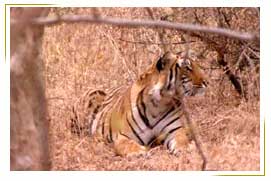 Ranthambore is internationally acknowledged as one of the last remnants of the once great virgin jungles in central India. Situated in India’s northwestern state of Rajasthan, it is surrounded by the Vindhya and Aravali hill ranges and lies near the outer fringes of the Thar Desert. The entire area of 390 sq km is located 500 m above sea level and is a sprawling tract of desert and semi-desert vegetation. Originally a hunting ground of the Maharaja of Jaipur, Ranthambore was declared a game sanctuary in 1955. In 1980s, it became a national park and was listed among the reserves protected under Project Tiger (1973). Presently the Kaila Devi Sanctuary, also famous for its tigers, and the Man Singh Sanctuary form a part of Ranthambore Reserve. Ranthambore is internationally acknowledged as one of the last remnants of the once great virgin jungles in central India. Situated in India’s northwestern state of Rajasthan, it is surrounded by the Vindhya and Aravali hill ranges and lies near the outer fringes of the Thar Desert. The entire area of 390 sq km is located 500 m above sea level and is a sprawling tract of desert and semi-desert vegetation. Originally a hunting ground of the Maharaja of Jaipur, Ranthambore was declared a game sanctuary in 1955. In 1980s, it became a national park and was listed among the reserves protected under Project Tiger (1973). Presently the Kaila Devi Sanctuary, also famous for its tigers, and the Man Singh Sanctuary form a part of Ranthambore Reserve.
Ranthambore is probably the best place in the world to photograph the mighty and powerful tiger. Jeep Safaris are exciting options and the chances of spotting a big cat is better than anywhere else in India. Excursions around the park give valuable insights into the culture and tradition of the local people especially the Meena tribes. One can also look for medieval splendour in the form of forts, havelis (mansion), and palaces that are scattered throughout the region. Spending the nights in the many hideouts in the park is another adventurous option.
In 1955, Ranthambore became a sanctuary and was one of the very first protected areas. Later in 1984, the park was notified as a National Park with an area of around 400 square kilometres and today according to rough estimates, the park has a tiger population of a little over a hundred.
Ranthambore, which receives thousands of visitors each year, is most famous for its tigers. Tigers here can be spotted quite often in their natural habitat even during daytime. They have been frequently seen at the edges of three lakes-Padam Talab, Raj Bagh Talab and Milak Talab. The park also has panthers in sizable numbers, though they have been spotted generally at the outskirts of the park perhaps due to the inevitable conflict with the tiger population, which command the ‘superior’ position amidst the predatory cats. For spotting panthers, Kachida Valley is regarded as the ideal place.
Other mammalian species that can be seen at Ranthambore are antelopes, nilgai, sambhar, chital, sloth bear, wild boar, chinkara, porcupines, jackals, leopards, jungle cats, fox, caracals, hyena, gazelle, Indian hare, mongoose and jacanas. Sambhars are in abundance at the park and form the prime target of all the predatory mammals. Monitor lizards and marsh crocodiles are also found here.
There are about 264 species of birds found within the park including painted storks, white-necked storks, black storks, peafowl, crested serpent eagles, Bonelli's eagle, Indian horned owl, quail, partridge, spur fowl, paradise flycatcher, and jacanas. During winters, migratory birds like graylag goose, ruddy shelduck and pintails can also be spotted.
The Ranthambore Park’s topography varies from secure forests to open scrublands. Vegetation is of the dry deciduous type, with dhok being the most prominent tree. The water bodies in Ranthambore are known to have lovely lotus flowers and water lilies. Among the park’s other attractions is the forest rest house, Jogi Mahal, the premises of which houses the second largest banyan tree in India.
Rajasthan hotels booking services for accommodation.
Ranthambore is one of the most suitable places for wildlife photography in the world. The park can be toured in a jeep or lorry-van. A guide and a park ranger generally accompany tourists. There is a network of four travel tracks inside the park for safaris. Ruins within and around Ranthambore bear testimony to its royal past. There are lake palaces, old fortifications and the majestic Ranthambore fort at a height overlooking the park. The forest rest house is situated at the foot of the fort within Jogi Mahal. Wildlife Tours India
By virtue of its proximity to the Thar Desert, the region suffers extremities of climate. Summers (April-June) are particularly harsh with temperatures going well over 40°C. The area receives rainfall in July and August. The onset of winter (October-March) brings down the temperature and which is an encouragement to tourists to visit Ranthambore. The park is open between the months of October and May. The best months to visit the park are from October to February.
| 

